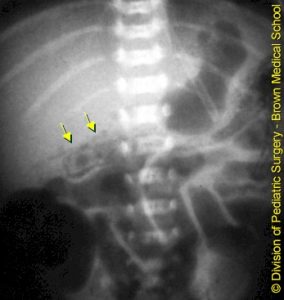A 12yo boy with ALL, recent induction chemotherapy 2 weeks ago, presents to the ED with fever, RLQ abdominal pain, 2 episodes of watery diarrhea with streaks of blood, nausea but no vomiting. Denies ill contacts. On exam, temperature 38.4, HR 110, RR 24, BP 95/60. Alert, no nuchal rigidity, lungs clear to auscultation, heart RRR, abdomen mildly distended, RLQ tenderness, no rebound, decreased bowel sounds. Labs show an absolute neutrophil count of 100. KUB findings are similar to as shown here:

The most appropriate next step would be:
A. Consult surgeon for appendectomy
B. Admit for IV antibiotics directed at treating infectious diarrhea
C. Admit for empiric IV antibiotics to cover for fever and neutropenia
D. Admit for broad spectrum antibiotics, make NPO, consult with surgeon, consider GCSF, for neutropenic enterocolitis
E. Consult gastroenterologist for endoscopy to confirm pseudomembranous colitis
December 31, 2016 at 3:29 am
D. The patient is presenting with a history concerning for typhlitis, also known as neutropenic enterocolitis, which typically occurs in neutropenic oncology patients undergoing chemotherapy. Symptoms include abdominal pain, especially RLQ, nausea, vomiting, watery and sometimes bloody diarrhea, and may progress to perforation and peritonitis. Plain films may show pneumatosis intestinalis, as seen here, but CT is the imaging study of choice. Treatment includes bowel rest, broad spectrum antibiotics covering gram negative organisms, sometimes surgery if perforation or abscess occurs. GCSF is controversial but may be beneficial. Patients should be monitored in an ICU setting as mortality rates are high.